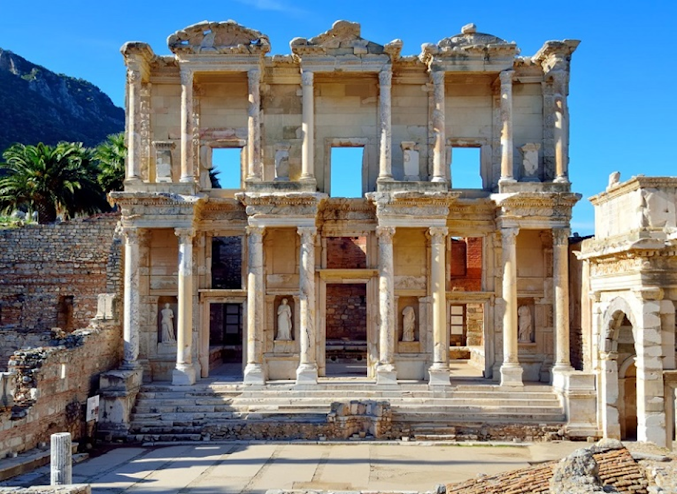The Library of Celsus
If you do
a search for ‘Ephesus’ in any search engine, you will find a picture of the
Library of Celsus. That, I suppose, is the modern meaning of the word ‘iconic.’
It was built around 117 CE by Tiberius Julius Aquila Polemeanus in honor of his father, Tiberius Julius Celsus Polemeanus. Celsus started his cursus honorum as a junior officer in a legion, and continued through successive promotions to become the Legate of a legion, a Senator, a Consul, and, eventually, the Governor of Asia. Aquila, who also attained the rank of Consul, buried his father in a vault beneath their new library. His statue occupied a place of honor in the reading room.
From “The Missing Book”
 |
| Celsus |
"Although Meliton loved his new job, on this particular
day, 910 years since the founding of
Rome and four days before the Ides of April, he was momentarily bored
and walked outside just as the sun rose above Mount Pion and spread its warmth
across the plaza between the library and the street. It was cool inside the
library, deliberately so, because its double walls with an air space in between
were cleverly designed to keep the interior cool, even in the blazing heat of
summer. Its façade faced east, so that the slanting sun cast patterns of light
and shade on its purple-veined columns and highlighted four female statues in
their alcoves, representing Wisdom, Goodness, Knowledge, and Understanding.
Meliton had received his training on the island of Kos, where the library was
smaller, its collection more modest. Here, the Library of Celsus was built to
be nothing other than a library, and its collection had grown upon the wealth
of the Polemaeanus family, no expense spared. It was one of the greatest
libraries in the Roman Empire, superseded only by Trajan’s Library in Rome and
Hadrian’s in Athens. The resources left by Tiberius Julius Celsus Polemaeanus to his son seemed vast to Meliton, but the
resources of the Emperors, surely, had been greater still."
It is commonly estimated that
the Library contained around 12,000 books. Although the word ‘book’
nowadays means something printed on paper and bound between cardboard covers,
in Ephesus in the 2nd century CE, books were handwritten by their authors,
or more commonly copied by professional scribes, on to papyrus sheets that were
sewn together to form a roll which, if unrolled, would stretch to thirty feet
or more. Entirely organic, books faded from exposure to light and were commonly
attacked by mold, maggots, and mice. The ideas found in books might have been
eternal, but books were not. Libraries hired scribes to copy and recopy their books
to keep them readable and, equally important, to make them available to other
libraries. As a commodity, books could be sold for a profit.
To read a book, a reader would unroll the first few sheets of text and stretch them flat between two wooden spools. When these sheets were read, the reader would roll them on to the second spool while unrolling more sheets from the first. Modern readers would reasonably expect that this method of reading would require a table, but G. W. Houston in Inside Roman Libraries says that he was unable to find any contemporaneous pictures of Romans reading at tables, but found many showing Romans with scrolls spread across their laps.
Instead of shelves, books in libraries were stored in cubby holes. In the Library of Celsus, the rectangular spaces once occupied by cubby holes are built into the walls. Inside each cubby, scrolls were stacked on wooden shelves. Since the title and author of a rolled-up scroll would be hidden, each book had an exterior tag displaying identification details. These tags, according to G. W. Houston were known as sillyba (singular sillybon)—temptingly close to our modern word syllabus.
The Library of Celsus occupies a central location at the foot of Curetes Street in the ruined city. It’s a beautiful building, intriguing the eye with its clever interplay of columns and archways on the first and second floor. No wonder that tourists tend to gather in the forecourt, take their selfies, and eat their sandwiches on the steps. Occasionally, the Ministry of Tourism offers a concert of classical music in the forecourt, starting at sunset, a memorable experience for those lucky enough to be there.



Comments
Post a Comment